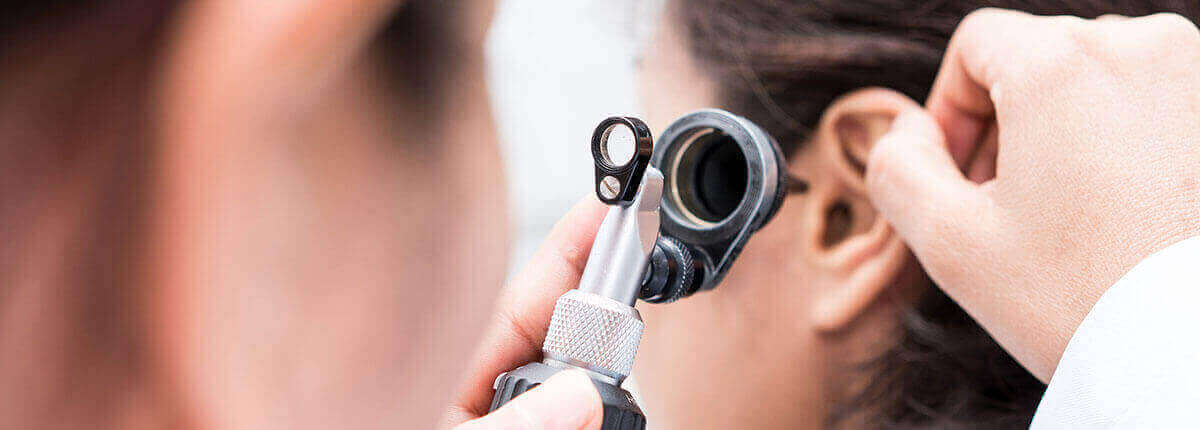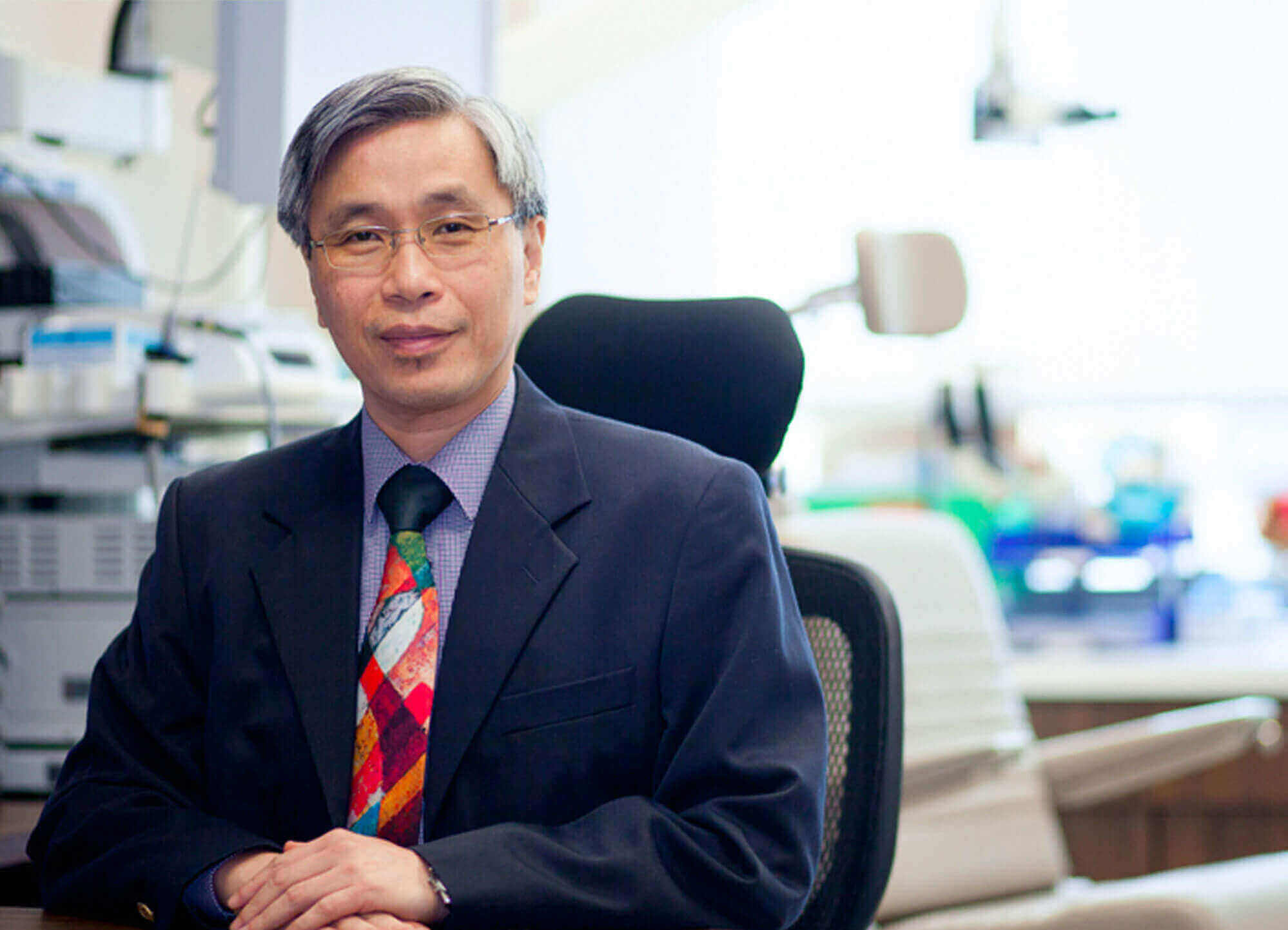
Sound enters the ear via the external ear canal. The sound vibrates the eardrum located at the deep end of the ear canal. The middle ear space lies behind the eardrum and is connected to the back of the nose (nasopharynx) by the Eustachian tube which serves to ventilate the middle ear. The air-filled middle ear space houses the ossicular chain, which consists of 3 bones (malleus, incus and stapes). The ossicular chain serves to transmit vibrations of the eardrum to the inner ear where the cochlear hair cells transform the incoming mechanical energy into electrical energy. The electrical signals can then be transmitted along the hearing nerve to the brain where it is perceived as sound.
Hearing loss results from disorders of the external (eg ear wax), middle (eg ossicular chain disruption or fixation) or inner ear (eg old age, noise-induced). Hearing loss can be conductive, sensori-neural or both. Conductive hearing loss affects the sound-conducting mechanism in the external or middle ear. Sensori-neural hearing loss is the result of damage to the cochlear (inner ear) cells or retro-cochlear nervous pathways (auditory nerve and central nervous system).
Hearing loss can sometimes be due to some serious underlying conditions. For example, hearing loss can be a presentation of nasopharyngeal carcinoma (NPC), a cancer arising from the back of the nose. It can also be a manifestation of a tumour of the hearing nerve (acoustic neuroma). Hearing loss can also be due to systemic conditions such as auto-immune diseases or certain infections.
Sometimes, hearing loss develops suddenly in one ear. Sudden sensori-neural hearing loss is usually due to a virus infection and early treatment offers the best chance of recovery.
Untreated chronic hearing loss has also been associated with the development of dementia.
Normal hearing is critical to a child’s speech and language development, communication and learning. Hearing loss causes delay in the development of receptive and expressive communication skills (speech and language). The resultant language deficit also causes learning problems and reduced academic achievement.
Childhood hearing loss is relatively common. About 5 in 1,000 babies are born with some degree of hearing loss. which can be detected by universal newborn hearing screening. Hearing loss can also develop later on in childhood. This is commonly due to middle ear effusion (glue ear).as a result of Eustachian tube dysfunction.
The desired ultimate outcome in the management of children with irreversible hearing loss is successful integration into mainstream society. In addition to treating the hearing loss and addressing the individual needs of each child, it is essential that an effective system be in place to promote early detection, effective early intervention and mainstream school support. With this holistic approach, it was deemed that at least 80% of children born with significant deafness could cope well in mainstream education, integrate into mainstream society successfully and contribute effectively to society
A team of professionals is available to accurately document the type and degree of hearing loss as well as to establish the underlying cause(s). These are essential pre-requisites before treatment can commence in a meaningful way.
The first step to treating hearing conditions is an accurate diagnosis. We offer a range of industry-standard diagnostic tests, performed by our experienced team in dedicated hearing assessment facilities. These include Pure Tone Audiometry, Tympanometry and Acoustic Reflex Test.
Accurately assessing hearing loss in infants and young children requires a specialised set of skills and diagnostic tests. The tests are often done in the Clinic with the child sedated. We recognise that children are not merely little adults and they (as well as their parents) have specific needs. Our team has significant experience in caring for paediatric patients with hearing conditions. They are supported by our centre’s specialised paediatric facilities including an audiometry booth and an evaluation and procedures room designed for the young. The tests that are offered include Auditory Brainstem Response, Auditory Steady State Evoked Potential, Otoacoustic Emissions, High Frequency Tympanometry, Visual Reinforcement Audiometry and Play Audiometry.
Some patients with conductive hearing loss resulting from middle ear infections recover after a course of antibiotics and nasal decongestants. Sensori-neural hearing loss resulting from Meniere’s Disease may respond to diuretics, and that from syphilitic otitis may improve with antibiotics.
Sudden hearing loss is a condition where one perceives a loss of hearing (usually in only one ear) suddenly or over a period of hours. The exact cause is largely unknown (idiopathic), but viral, vascular and auto-immune causes had been suggested. The recommended treatment includes steroids which can be injected into the middle ear for maximum benefit and possibly hyperbaric oxygen therapy. It is important that treatment be started as early as possible, in order to maximise the chances of recovery.
Conductive hearing loss can generally be rectified by appropriate surgery, so that the mechanical energy from sound can reach the inner ear where it is converted to electrical energy by cochlear hair cells. For example, tympanic perforations can be repaired (tympanoplasty surgery) and the fixated stapes in otosclerosis can be replaced by a prosthesis (stapedectomy surgery).
Surgery generally cannot restore physiological sensori-neural hearing, as the loss is usually a result of irreversible cochlear hair cell damage. An exception could be sensori-neural hearing loss due to disturbed cochlear function from a perilymph fistula, where successful surgical repair can restore inner ear function.
There have been major advancements in the area of hearing technology to help people better cope with hearing impairments. Hearing aids, cochlear implants and implantable hearing devices are some of the available options.
Modern digital hearing aids have added features and processing schemes that were previously not possible with the analogue technology, making hearing amplification better and more comfortable. It is still a challenge, however, to develop hearing aids capable of enabling patients to understand speech in noisy environments. Besides better functioning, there is a trend towards increasing miniaturisation, which has progressed from body-worn aids, to aids worn behind the ear and in the ear canal. FM systems can be used to enhance the effectiveness of hearing aids, by improving signal-to-noise ratio. The latest in hearing aid technology features automatic digital signal processing, multiband adaptive directionality, wind noise management, multiple listening programs, data logging/learning, water-resistant technology, wireless Bluetooth capability and more.
Newer hearing aid technologies include those which can be implanted into the middle ear. The potential advantages of implantable hearing aids are the elimination of feedback and the occlusion effect, as well as improved fidelity and cosmesis. There are also bone-anchored hearing aids, where the hearing aid is fitted onto a titanium screw, which bio-integrates with the mastoid bone. There is a newer version that works on the same principle but does not require the use of a titanium screw. This type of hearing aid is useful for patients who are not able to wear a hearing aid in the ear canal, such as those with chronic ear infections, stenotic ear canal or aural atresia.
Besides devices that can amplify sounds, there are assistive tools which can help the profoundly deaf cope better in day-to-day activities. For example, silent vibrating alarm clocks and door-bells with flashing lights are available.
Some patients have cochlear hair cells so severely damaged that conventional hearing aids are of inadequate benefit. Such patients may benefit from the cochlear implant, which does not rely on viable cochlear-hair cells to work. Many patients both children and adults have been implanted and the results of cochlear implantation had generally been very good. There has also been increasing evidence to show that cochlear implantation is beneficial even in patients with irreversible one-sided severe to profound hearing loss (with normal hearing on the other ear), especially when of recent onset and associated with disturbing tinnitus.
Coping with hearing impairment takes more than medical treatment. Our holistic approach to caring for hearing health extends to therapy and counselling services to help not only patients of all ages, but their family members, caregivers and even teachers in school. These efforts are led by our Audio-Verbal Therapist.
Senior Consultant Ear, Nose & Throat Surgeon
Sub-specialty in Otology & Neuro-otology
MBBS (S’pore), PhD (S’pore)
FRCSG, FRCSEd, DLORCSEng, FAMS (ORL)
GradDip (Acupuncture)

If you have any inquiries or would like to request for further information regarding our services,
please contact us by calling our clinic or sending us an email. We will attend to your request as soon as possible.